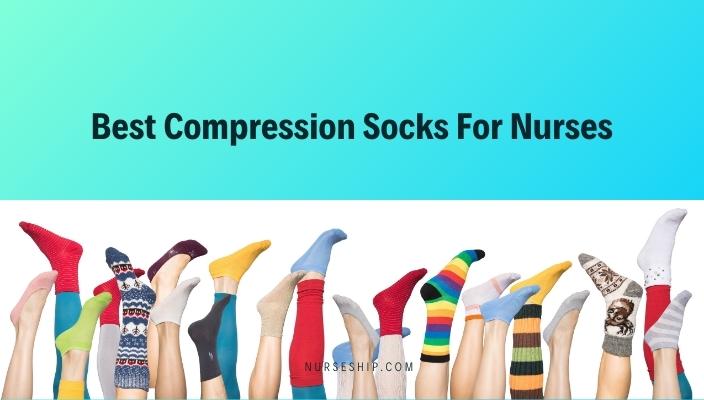If you’re a nurse, you know all too well the toll that long hours of standing and non-stop work can take on your feet.
From plantar fasciitis to foot swelling and blisters, these problems can make each shift feel like a marathon.
That’s why wearing compression socks is crucial for nurses. Not only can they improve blood circulation and reduce inflammation, but they also provide relief from leg fatigue and soreness.
In this article, we’ll be reviewing and comparing several popular compression sock options on the market today.
7 Best Compression Socks for Nurses (2023)
Following are our picks of the best 7 compression socks for nurses for 2023.
Bluemaple Copper Compression Socks for Nurses

- Copper-infused fabric for anti-odor and moisture-wicking properties
- Targeted compression for improved circulation
- Reinforced toe and heel for durability
- Seamless construction for enhanced comfort
- Available in a range of sizes and colors
Pros:
- Versatile design for various activities
- Copper-infused fabric for anti-odor and moisture-wicking properties
- Graduated compression for improved circulation
- Reinforced toe and heel for durability
- Available in a range of sizes and colors
Cons:
- Some users may find the compression level to be too tight
The Bluemaple Copper Compression Socks are made of high-quality materials that are durable and built to last.
The seamless construction and reinforced toe and heel ensure that these socks can withstand the demands of daily use without compromising on comfort.
Upgrade your nursing uniform with these top-quality compression socks and enjoy the benefits they bring to your busy and active lifestyle.

Doc Miller Open Toe Compression Socks for Women (1 Pair, 20-30mmHg)

Key features of the Doc Miller Premium Open Toe Compression Socks Dress Series:
- 20-30mmHg compression level
- Open-toe design for maximum breathability
- Graduated compression for targeted support
- Stylish and professional dress sock appearance
- Made from high-quality materials for durability and long-lasting comfort
Pros:
- Provides targeted support and relief
- Stylish design for a professional appearance
- Easy to put on and take off
- Allows toes to move freely for added comfort
- Suitable for all-day wear
Cons:
- May be slightly pricier compared to other compression socks on the market
The Doc Miller Premium Open Toe Compression Socks Dress Series are an excellent choice for nurses seeking both comfort and style.
Experience the benefits of improved blood circulation and reduced leg fatigue and swelling while still looking professional and fashionable.

5 Pairs of Medical Compression Socks for Men and Women – Support for Running, Nurses, Flight, Pregnancy, Circulation, and Athletics

- Effectively improves blood circulation
- Reduces leg fatigue and muscle soreness
- Breathable and moisture-wicking materials keep feet dry
- Versatile and suitable for various activities
- Reinforced heel and toe for added durability
- May feel tight initially
These compression socks are the perfect companion for nurses, runners, and pregnant women who spend long hours on their feet.
Experience unparalleled comfort, improved circulation, and reduced swelling with these top-quality compression socks.

Compression Socks for Women & Men – Best Support for Nurses (8 Pairs, 15-20 mmHg)

Key features of the CHARMKING Compression Socks include a multicolor combo, allowing you to choose a color combination of your choice.
This means you can have a pair of socks for each day of the week without needing to wash them daily.
The socks are also designed with a high-quality stitch and are easy to put on, even though they are compression socks.
Pros:
- Provides optimal compression and support for nurses
- Targeted compression zones for varying levels of support
- Made from high-quality materials for flexibility and durability
- Breathable high-performance fabric keeps feet at an optimal temperature
- Multicolor combo allows for a different pair of socks each day of the week
Cons:
- May feel tight initially for those not used to compression socks
Give your feet the comfort and support they deserve with the CHARMKING Compression Socks!

Jobst Relief Compression Socks for Nurses

- Provides excellent compression and support
- Versatile closed-toe design
- Reinforced heel and toe for added durability
- Range of colors to choose from
- Easy to put on and take off
- Slightly pricier compared to other brands
- May be tight for individuals with larger calves
With the Jobst Relief Closed Toe Knee Highs 20-30 mmHg, you can experience unrivaled comfort and support throughout your nursing shift.
These compression socks are the perfect companion for nurses and healthcare professionals, allowing you to focus on your patients without worrying about leg fatigue or discomfort.

CHARMKING Compression Socks (3 Pairs) for Women & Men – Best Support for Athletes’ Circulation in Running and Cycling (15-20 mmHg)

- Perfect level of compression for nurses
- Breathable and moisture-wicking
- Durable construction
- Available in a variety of colors and patterns
- Excellent value for money
- May feel slightly tight for those with larger calves
The CHARMKING Compression Socks for Women & Men Circulation (3 Pairs) 15-20 mmHg is the ideal choice for nurses seeking reliable support and comfort throughout their shifts.
With its excellent construction, vibrant designs, and moderate compression level, these socks will provide you with the necessary comfort and support to keep you going strong throughout the day.

Hebe 4 Pairs Compression Socks for Women and Men – Best Support for Nurses, Running, Athletic Circulation

Key Features include:
- Graduated compression technology
- Seamless toe design
- Moisture-wicking properties
- Reinforced heel and toe
- Durable and breathable material
- Effective at reducing leg fatigue and swelling
The Laite Hebe 4 Pairs Compression Socks are an excellent choice for nurses seeking optimal support and circulation.
With their advanced features and high-quality construction, these socks deliver on their promise to alleviate leg fatigue and prevent varicose veins.
Grant your feet the comfort they deserve with the Laite Hebe Compression Socks.

Comparison of Compression Socks for Nurses
| Product | Compression Level | Key Features |
|---|---|---|
| Bluemaple Copper Compression Socks | Not specified | Copper-infused fabric, multiple colors, support |
| Doc Miller Premium Open Toe Compression Socks | 20-30mmHg | Open-toe design, targeted compression |
| Toeless Compression Socks Women | 15-20mmHg | Medical support, toeless design |
| CHARMKING Compression Socks (8 Pairs) | 15-20mmHg | Variety of colors, high-performance fabric |
| Jobst Relief Closed Toe Knee Highs | 20-30mmHg | Higher compression, therapeutic benefits |
| CHARMKING Compression Socks (3 Pairs) | 15-20mmHg | Moderate compression |
| Laite Hebe Compression Socks | 15-20mmHg | Supportive, multiple colors |
Conclusion: A Comprehensive Review of Compression Socks
After reviewing all seven products, it is evident that compression socks are highly beneficial for a wide range of individuals.
They are particularly useful for athletes, runners, nurses, frequent flyers, and those seeking improved circulation.
Each of the reviewed products offers varying levels of compression and diverse features to cater to different needs.
Recommendation:
If you are an athlete or engage in physical activities regularly, the CHARMKING Compression Socks (8 Pairs) would be perfect for you. They offer moderate compression and come in a variety of colors, making them both practical and fashionable.
For individuals who require targeted therapeutic benefits, such as those with serious circulation issues, the Jobst Relief Closed Toe Knee Highs are recommended. However, keep in mind that these socks have a higher compression level and may not be comfortable for all-day wear.
Regardless of the specific product you choose, incorporating compression socks into your routine can provide immense benefits for circulation, support, and performance during various activities. So go ahead and pick the one that suits your needs best – your feet will thank you!
FAQs
Why Should a Nurse Wear Compression Socks?
Wearing compression socks is highly beneficial for nurses, especially those who spend long hours standing and working without breaks.
The nature of their profession puts them at risk of various foot problems, which can be alleviated by wearing compression socks.
Here are a few reasons why you as a nurse should consider wearing compression socks.
Prevent leg fatigue caused by long hours of standing
One of the main advantages of wearing compression socks is that they can help prevent leg fatigue.
If you spend long hours standing or sitting, you may notice that your legs become tired and achy.
Compression socks work by providing gentle pressure on your legs, which helps to improve blood circulation.
The improved blood flow can reduce the feeling of heaviness in your legs and prevent fatigue, allowing you to stay comfortable throughout the day.
Improves blood flow
Another significant benefit of compression socks is their ability to enhance blood flow.
When blood circulation is enhanced, oxygen and nutrients are delivered more efficiently to the muscles and tissues in your legs.
This can improve your overall performance during physical activities and aid in muscle recovery after workouts.
Additionally, proper blood flow can help reduce the risk of blood clots, keeping your legs healthy and preventing more serious complications.
Reduce inflammation and promote healing
Nurses are often exposed to situations that can result in inflammation, such as standing for long periods of time or engaging in physical activities.
Compression socks are designed to reduce inflammation and promote faster healing.
The gentle pressure exerted by the socks helps to reduce swelling and inflammation by preventing the accumulation of fluid in the affected areas.
Moreover, compression socks promote the flow of oxygen and nutrients to the muscles, which aids in the healing process.
By facilitating the removal of metabolic waste products, compression socks help to speed up recovery and alleviate discomfort.
For nurses who are constantly on their feet and susceptible to inflammation, wearing compression socks can make a significant difference in their overall well-being.
Provide relief from lymphedema
Lymphedema is a condition characterized by the accumulation of lymphatic fluid, resulting in swelling and discomfort.
Nurses, particularly those who have undergone surgical procedures or have an increased risk due to their medical history, are prone to developing lymphedema.
Compression socks are an effective tool in managing this condition.
By applying gentle pressure to the affected areas, compression socks help to stimulate lymphatic drainage and reduce swelling.
The graduated compression provided by these socks encourages the proper movement of lymphatic fluid, preventing the buildup that leads to discomfort.
For nurses experiencing the symptoms of lymphedema, wearing compression socks can provide much-needed relief and allow them to carry out their duties without added discomfort.
Prevent varicose veins and vein problems
Compression socks are also effective in preventing varicose veins and other vein problems.
Varicose veins occur when the valves in your leg veins become weakened or damaged, resulting in blood pooling and the veins becoming enlarged and twisted.
By applying pressure to the legs, compression socks help to improve the blood flow toward the heart, reducing the risk of varicose veins and venous disorders.
Regular use of compression socks can provide great long-term benefits for your leg health.
Choosing the Right Length
Compression socks come in various lengths to suit different needs and preferences. Here are two common options you can choose from:
Thigh highs
Thigh-high compression socks extend up to the upper thigh, providing compression and support to a larger portion of your leg.
They are a great option if you are looking for maximum coverage and support, especially if you have issues with varicose veins or swelling in the thigh area.
Thigh-high compression socks are also commonly recommended for individuals recovering from surgery and in need of extensive leg support.
Knee highs
Knee-high compression socks, as the name suggests, cover the leg up to the knee.
They are a versatile option that offers support to the calf muscles and reduces the risk of swelling in the lower leg.
Knee-high compression socks are particularly suitable for individuals who are on their feet for long periods, as they help alleviate leg fatigue and promote blood circulation.
They are also more convenient to wear, as they can be easily paired with different types of footwear.
When choosing the right length of compression socks, consider your specific needs and preferences.
If you require maximum coverage and support, thigh highs may be the better choice. If you primarily want support for your calf muscles and lower leg, knee highs are a suitable option.
Choosing the Right Compression Grade
Compression socks are available in different compression grades, which refer to the amount of pressure they provide.
The appropriate compression grade for you will depend on your individual needs and any underlying medical conditions.
Here are some common compression grades and their recommended uses:
20-30 mmHg
For nurses working long hours, the commonly recommended compression grade is 20-30 mmHg.
It provides moderate pressure and is suitable for preventing leg fatigue, varicose veins, and swelling.
It can also assist in post-workout recovery and improve blood circulation.
Other compression grades
Compression socks are available in a range of other compression grades, including 8-15 mmHg, 15-20 mmHg, 20-30 mmHg, and higher.
Lower compression grades are suitable for individuals with milder symptoms or as a preventative measure, while higher compression grades are often recommended for more severe medical conditions.
It is important to consult with a healthcare professional to determine the appropriate compression grade for your specific needs.
| Situation | Compression Level |
|---|---|
| Air travel | 8-15 mmHg |
| Daily use | 8-15 mmHg |
| Pregnancy or varicose veins | 15-20 mmHg |
| Intense workout/Standing long hours at work | 20-30 mmHg |
| Doctor’s advice or post-surgery | 30-40 mmHg |
| Under medical supervision (40-50 mmHg) | 40-50 mmHg |
Considerations for Healthcare Professionals
Healthcare professionals, including nurses and doctors, often have specific requirements when it comes to compression socks.
Here are some factors to consider when choosing compression socks for healthcare professionals:
Durability
Compression socks for healthcare professionals should be durable and able to withstand daily wear and repeated washings.
Look for socks made of high-quality materials and reinforced stitching to ensure longevity.
Ease of cleaning
For healthcare professionals who have to maintain strict hygiene standards, compression socks that are easy to clean are essential.
Opt for socks that can be machine-washed and dried without losing their shape or compression properties.
Comfort
Comfort is crucial, especially for healthcare professionals who are on their feet for long periods.
Compression socks should have a snug fit without being too tight or restrictive. Look for socks with cushioned soles and seamless toes to minimize discomfort during extended wear.
Appearance
While functionality is key for healthcare professionals, many also want compression socks that look professional and presentable.
Choose socks that come in a range of colors and styles to suit different uniform requirements.
Consider options with moisture-wicking properties to keep feet dry and odor-free.
Overall, healthcare professionals should prioritize durable, easy-to-clean, comfortable, and presentable compression socks to support their leg health while maintaining their professional appearance.
How to Properly Measure for Compression Socks
To ensure the effectiveness and comfort of compression socks, it is crucial to measure your legs correctly.
Here are steps to determine the correct size:
Determining the correct size
Using a measuring tape, measure the circumference of your ankle, calf, and thigh, depending on the desired length of your compression socks.
Record the measurements in inches or centimeters.
Measuring techniques
To measure the ankle circumference, wrap the measuring tape around the narrowest part of your ankle.
For the calf circumference, measure the widest part. For the thigh circumference, measure approximately two inches or five centimeters below the fold of your buttocks.
Refer to the size chart provided by the manufacturer to select the appropriate size based on your measurements.
Sizes may vary between brands, so always refer to the specific size chart for the compression socks you are planning to purchase.
Different Types of Compression Socks
Compression socks come in various styles to suit individual preferences and needs. Here are three common types:
Open-toe compression socks
Open-toe compression socks have a hole at the toe area, allowing your toes to remain exposed.
These socks are ideal for individuals who prefer to wear open-toe shoes or have foot conditions such as bunions or claw toes.
They provide all the benefits of compression socks while allowing for more flexibility in footwear choices.
Closed-toe compression socks
Closed-toe compression socks cover the entire foot, including the toes.
They are the standard option for most individuals and offer complete coverage and support for the feet.
Closed-toe socks provide additional warmth and protection, making them suitable for colder climates or individuals prone to foot sensitivity.
Compression sleeves
Compression sleeves, as the name suggests, are sleeves that cover the calf muscles without covering the feet.
These sleeves are a popular choice among athletes and individuals who want targeted compression for the lower leg region.
They are designed to be worn with regular socks or barefoot, giving you more flexibility in terms of footwear choices.
Consider your preferences and specific needs when choosing the type of compression socks that will work best for you.
Each style has its own advantages, so select the one that aligns with your lifestyle and desired level of support.
Choosing the Right Material
Compression socks are available in various materials, each offering different benefits. Here are three commonly used materials:
Nylon
Nylon is a popular choice for compression socks due to its durability and elasticity.
It provides excellent compression while maintaining its shape and preventing sagging.
Nylon socks are also moisture-wicking, allowing your feet to stay dry and comfortable even during extended wear.
Spandex
Spandex is another commonly used material in compression socks.
It is highly elastic and provides a snug fit, ensuring adequate compression and support.
Spandex socks are lightweight and breathable, making them ideal for everyday use.
Cotton
Cotton compression socks offer a natural and breathable option. They are soft, comfortable, and suitable for individuals with sensitive skin.
Cotton also absorbs moisture, keeping your feet dry and preventing the build-up of odor-causing bacteria.
Consider your personal preferences, skin sensitivities, and the intended use of compression socks when selecting the right material.
Each material has its own unique properties, so choose the one that best suits your needs.
Proper care and maintenance
To prolong the lifespan and effectiveness of your compression socks, it is important to follow proper care and maintenance guidelines.
Here are some tips:
Washing instructions
Check the specific washing instructions provided by the manufacturer. Most compression socks can be machine-washed in cold or warm water using a gentle cycle.
Use a mild detergent and avoid harsh chemicals or bleach. To prevent snags or damage, wash the socks in a laundry bag or turn them inside out before washing them.
Drying instructions
Avoid using a dryer to dry your compression socks, as high heat can damage the elastic fibers.
Instead, lay the socks flat or hang them to air dry. Do not wring or twist the socks, as this can alter their shape and compression properties.
Replacing worn-out socks
Compression socks may lose their effectiveness over time due to normal wear and tear.
Pay attention to signs of wear and replace your socks when necessary.
If you notice that the compression level has significantly decreased, the fabric has become stretched or saggy, or there are visible tears or holes, it is time to replace the socks.
By following proper care and maintenance techniques, you can ensure that your compression socks remain in good condition and continue to provide the desired level of support for your legs.
Conclusion
By wearing compression socks, you can prevent leg fatigue, reduce the risk of varicose veins and other vein problems, and improve blood flow in your legs.
By prioritizing your leg health and making an informed choice, you can enjoy the benefits of compression socks and keep your legs feeling great.
Disclosure: As an Amazon Associate, I earn from qualifying purchases.




